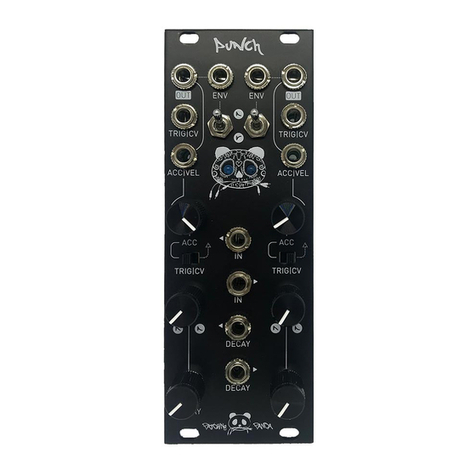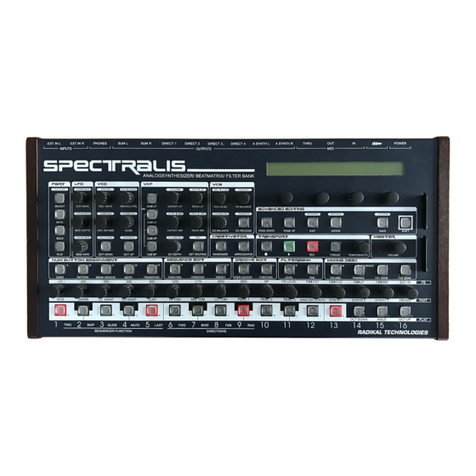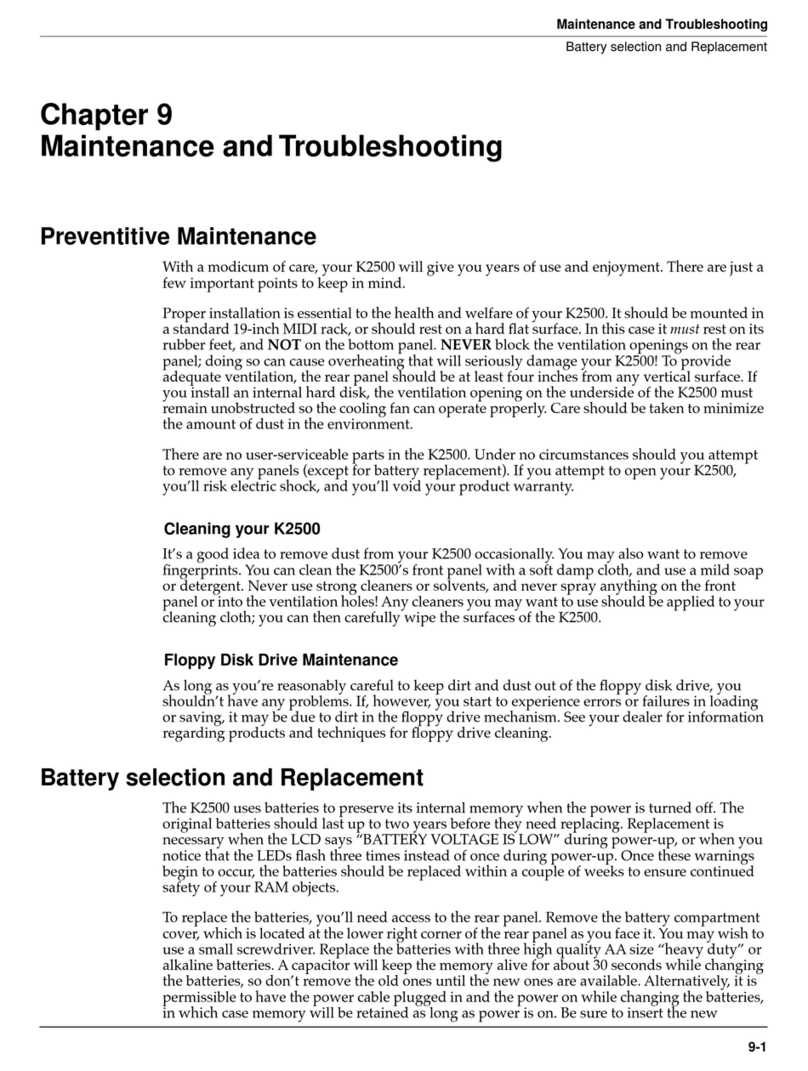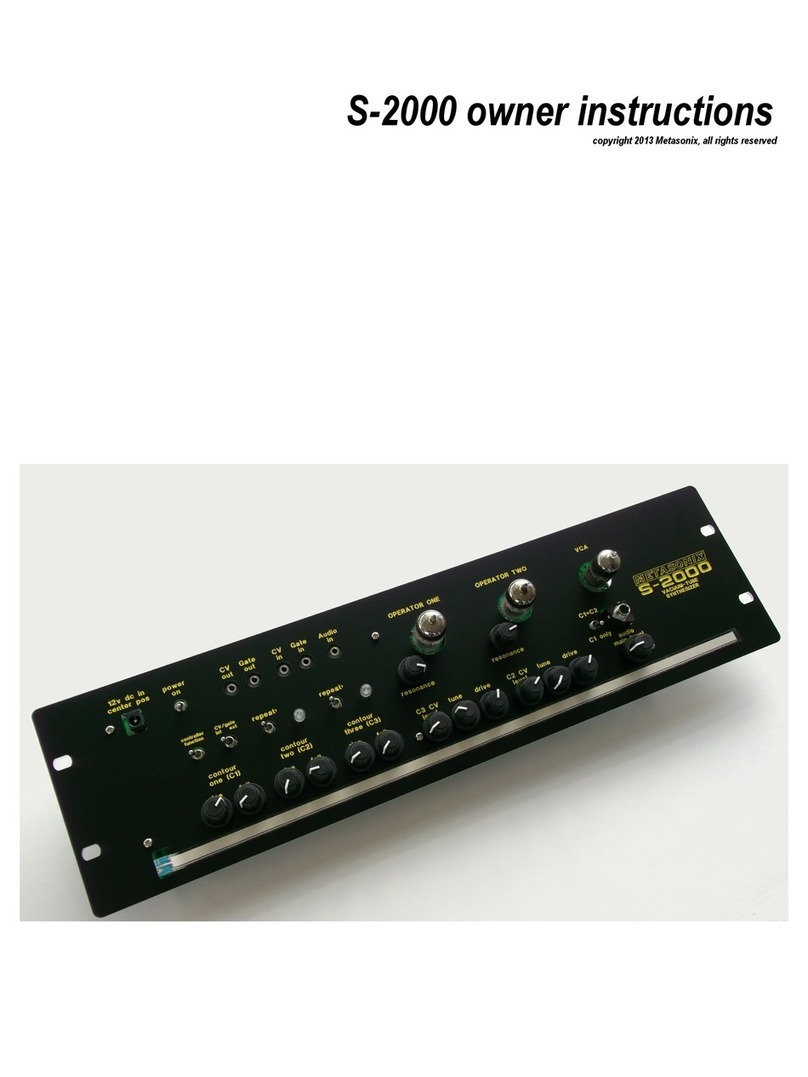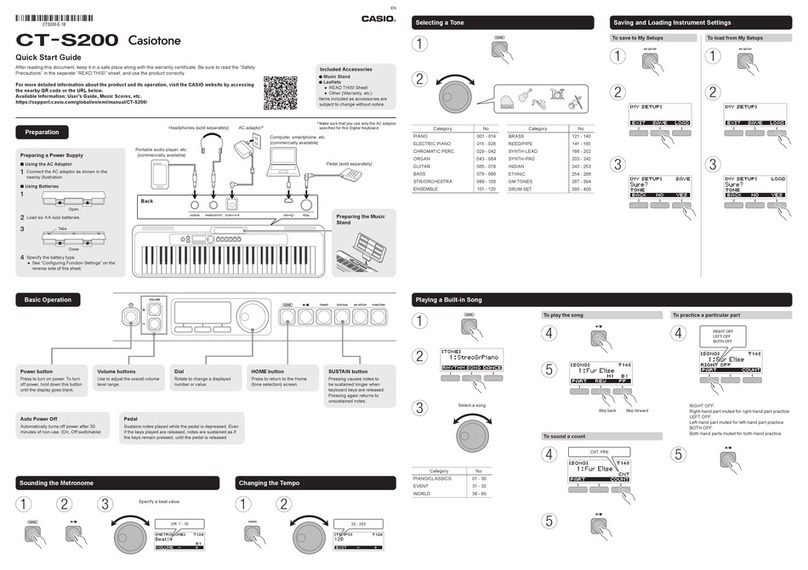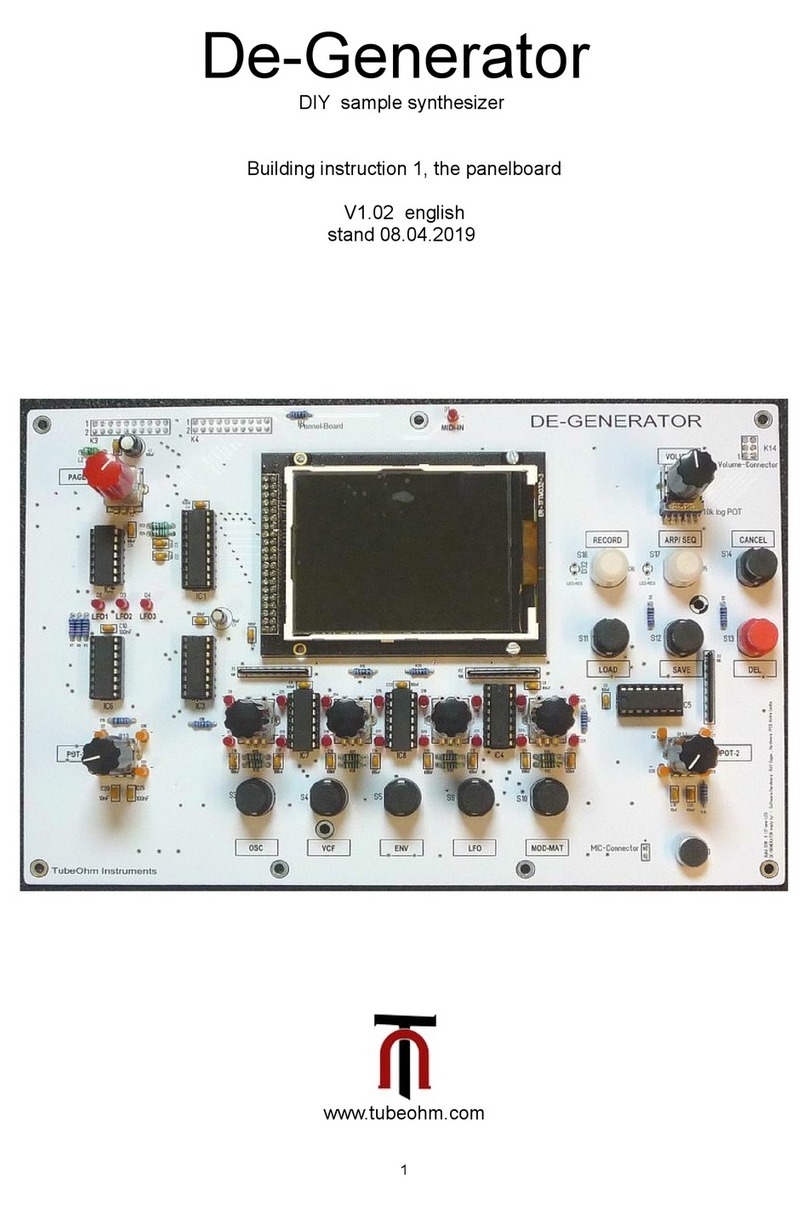Shakmat Mod Medusa User manual

Shakmat
Mod Medusa
Building Guide
12HP Eurorack Module Built & designed in E.U. www.shakmat.com

Table of contents
www.shakmat.com •
Preamble
Component list & necessary tools
PCB details
Assembly
4.1 Back
4.1.1
Power header (2x5 pin)
4.2 Front
4.2.1 Electrolytic capacitors
4.2.2
Jack connectors
4.2.3
Tacticle switches
4.2.5
Potentiometers
4.2.6
LED push buttons
4.2.7
LEDs
First startup routine
.................................................................................................................................. 2
................................................................................... 3
.............................................................................................................................. 4
................................................................................................................................... 5
.............................................................................................................................. 5
............................................................................... 5
.............................................................................................................................. 6
.................................................................................... 6
.............................................................................................. 7
............................................................................................. 8
................................................................................................ 9
......................................................................................... 10
............................................................................................................. 11-12
.............................................................................................................. 13
1.
2.
3.
4.
5.

www.shakmat.com •
02/13
Thank you for purchasing a Shakmat DIY kit !
We spare no effort in our kit packing process to prevent any mistakes or
missing parts. In this document as well, we do our best to describe the assem-
bly process in the most practical and comprehensive way. If by any chance
there is a missing/damaged part in your kit or if you have any suggestion, feel
free to contact us via shakmat.com.
We strongly advise you NOT to spill all the bags open and mix their
components. Some of them are virtually indistinguishable (like LEDs that
all appear clear when inactive). We recommend to only take the neccesary
component out of its bag, or to empty the bags in separate & marked contai-
ners. For each step, next to the component’s graphic representation, there is a
reference indicating where to find it (i.e. P1 for Pack 1, or LP for Loose Part).
The assembly process will be dramatically simplified if you follow the order
defined by this building guide. We tested various orders of steps before finding
the most convenient, and the one presented here is the best!
1. Preamble

www.shakmat.com •
03/13
Pack 1
3x 22 µF electrolytic capacitors
4x Tactile switch
4x Tactile switch caps
4x Green LEDs
2x Amber LED push button
Pack 2
1x 2x5 pin power header
4x White LEDs
4x Metal potentiometers
4x Metal potentiometer nuts
1x White LED push button
Pack 3
12x Jack connectors
12x Jack connectors nuts
4x Green/amber dual color LEDs
1x Green/red LED push button
2. Component list & necessary tools
Pink anti-static wrap
1x PCB
1x Front Panel
Loose parts
4x Black rubber knobs
1x Power cable
1x User manual
Necessay tools
Soldering iron
Solder
Cutting pliers
Masking tape

www.shakmat.com •
04/13
3. PCB details
PCB
Front & back

www.shakmat.com •
05/13
4. Assembly
Place the power header, short pin
side in the holes. We recommend
you only solder one of the pins. Then
reheat your soldered point and
simultaneously press the plastic part
of the header against the PCB until
it’s flat. Take off the soldering iron but
keep pressing. Avoid touching the
pins themselves because they will
become hot very quickly and move
out of alignment within their plastic
bracket. Once you are satisfied with
you placement, solder the remaining
pins.
4.1 Back
4.1.1 Power Header (2x5pin) P2

www.shakmat.com •
06/13
Flip the PCB and solder the three
22µF capacitors. You must pay
attention to the orientation of these
components. The long leg indicates
the positive side, therefore it has to
match the little dot on the PCB
silkscreen.
4.2 Front
4.2.1 Electrolytic capacitors (x3) P1

www.shakmat.com •
07/13
Place and solder the 12 jack connec-
tors. Be sure to lay them completely
flat on the PCB before soldering. If
those jacks aren’t perpendicular, the
front panel will be very hard to
mount.
If one of the jacks is not perfectly
perpendicular with the PCB, you can
reheat the pads and push it down
with your thumb to re-align.
4.2.2 Jack connectors (x12) P3

www.shakmat.com •
08/13
It’s very important to solder the four
push buttons flat with the PCB. If
they are crooked or not thoroughly
pushed through, the caps won’t pop
properly through the front panel and
the buttons will be hard to press.
4.2.3 Tactile switches (x4) P1

www.shakmat.com •
09/13
Before soldering, you will have to cut
a little metal piece off the top of each
potentiometer, as shown in the
picture. This little stud prevents the
front panel from sitting properly. Use
some small & sharp cutting pliers for
this task.
Then, place the 4 potentiometers on
the PCB. Mount the front panel and
tighten the potentiometers nuts (this
will ensure a proper placement of
the pots) and then solder them.
Once you have soldered everything,
remove the nuts, the front panel and
proceed to the next step.
4.2.4 Potentiometers & nuts (x4) P2
Cut!
4x

www.shakmat.com •
10/13
Place the four LED push buttons on
the PCB matching the color as
indicated. As the buttons embed an
LED, you must pay attention to the
orientation. The three holes on the
PCB have to match the three moul-
dings on the base of the component
as shown below:
We recommand you the place the
front panel back on and tighten the
Length potentiometer nut before
soldering the LED buttons. Once you
have soldered everything, remove
the front panel and go to the next
step.
4.2.5 LED Push Buttons (x4) P1, 2 & 3
Red/green: P3
Amber: P1
Component
base
PCB
holes
Amber: P1
White: P2

www.shakmat.com •
11/13
4.2.6 LEDs (x4) P1, 2 & 3
Placing the LEDs requires a specific
orientation due to their polarity. The
long leg is the positive side and they
all go into the left holes of the PCB.
Place all the LEDs through the PCB
paying attention to the colors and
orientations but don’t solder them
now.
LED POLARITY!
Green LEDs ( Ax4) P1
White LED ( Cx4) P2
Amber/green LEDs ( Bx4) P3

www.shakmat.com •
12/13
Place some masking tape over
every LED hole on the front panel.
Be aware of not blocking any other
component’s hole with the tape.
The LEDs are special flat top
models intended to be mounted
flush with the front panel. The
masking tape will help you to do
this neatly.
Once the panel is ready, assemble
it with the PCB and place the four
nuts on the potentiomers. Once
everything is well secured, push
every LED through their hole until
they sit flush with the panel and
stick to the tape. Once they are all
in place, you can solder then trim
the legs.
You’re almost done! The last thing
to do is to tighten the knurled nuts
on the jack sockets. Finally, push the
four knobs onto their metal poten-
tiometer and the two button caps
on the Shift buttons.
Potentiometer nut P2
Jack nuts (x12) P3
Knobs (x4) LP
Push button cap (x2) P1

www.shakmat.com •
13/13
5. First startup routine
Make sure all the potentiometers are fully counterclockwise when turning
on your Mod Medusa for the first time. Plug in the power cable and make
sure the red side of the ribbon cable matches the -12V on the PCB. Now let's
plug the module into your system and test it. The module identifies the first time
it turns on and automatically starts the calibration and test routines.
Turn on your rack, the Mod Medusa Tap button will lit red and the Uni button is
dimmed. Without anything inserted into the jack sockets press the Uni button.
The Uni button is now on and the P Sync button is dimmed. Using four patch
cables, patch Out 1 to LNGHT, Out 2 to DNST, Out 3 to Shape and OUT 4 to
Sym, then press the P Sync button once. Wait until all four green out LEDs
light on.
Disconnect the four patch cables, and make sure the four potentiometers are
fully conterclockwise. The Tap button is lit green, pressing it makes it red, Uni
button is off, pressing it lights it on. P Sync button is off, pressing it lights it on,
LENGTH+ button is off, pressing it light it on.
All the table LEDs are on and mode LEDs are off. Pressing Shift < lights the
first mode LED. Pressing Shift > lights the second mode LED. Pressing Table
lights the third mode LED and pressing Mode lights the fourth mode LED.
Take a gate or clock output from another module and patch it to the Mod
Medusa following inputs : When connected to the Clock input the firt table LED
switch from green to amber. When connected to the VCA input, the second
table LED switch from green to amber. When connected to the RST input, the
third table LED switch from green to amber. When connected to the A GT
input, the fourth table LED switch from green to amber.
Disconnect the patch cable, and turn each of the four potentiometer fully
clockwise, when doing so each of the four output LED will dim accordingly to
the potentiometer position. Once every portentiometer as been fully turned, the
startup routine is done and your Mod Medusa is now fully functionnal.
If you made a mistake during the startup routine, you can relaunch it by main-
taining the TAP button when powering on your Mod Medusa.

www.shakmat.com
Other manuals for Mod Medusa
1
Table of contents
Other Shakmat Synthesizer manuals



